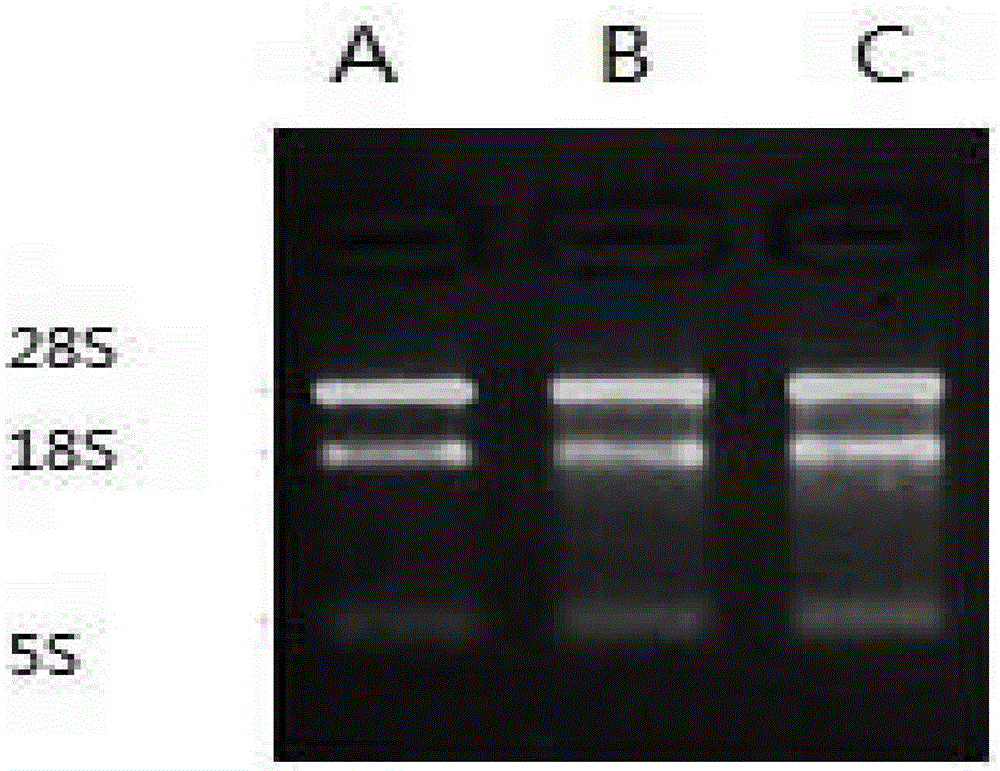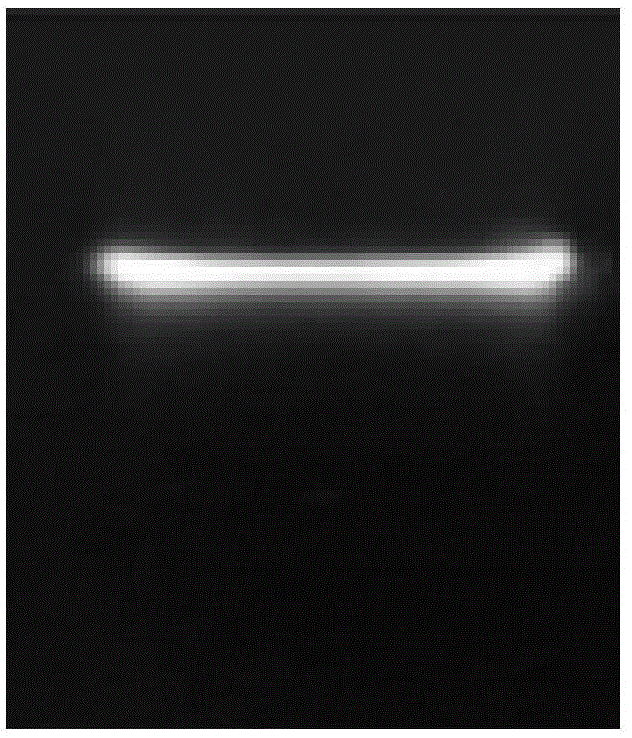Plant bleeding sap RNA extracting method
An extraction method and a technology of wounding fluid, which are applied in the field of agriculture, can solve the problems of inability to meet the needs of reverse transcription, insufficient RNA quantity, and rapid RNA degradation, so as to meet the needs of reverse transcription, increase the amount of RNA obtained, and inhibit RNA. Degradation effect
- Summary
- Abstract
- Description
- Claims
- Application Information
AI Technical Summary
Problems solved by technology
Method used
Image
Examples
Embodiment 1
[0024] A method for extracting RNA from plant wound sap, comprising the following steps:
[0025] 1) Freeze-dry 5ml plant wound liquid to 1 / 10 of the original volume, add 1400μl SDS, and bathe in water at 65℃ for 30min;
[0026] 2) Add 300 μl of water-saturated phenol, vortex, then add 300 μl of chloroform, vortex and mix, and centrifuge at 13,000 rpm for 10 min at 4°C;
[0027] 3) Take 1200 μl of supernatant to a new centrifuge tube, add 400 μl of water-saturated phenol, vortex to mix, then add 400 μl of chloroform, vortex to mix, and centrifuge at 13,000 rpm for 10 min;
[0028] 4) Add 1,000 μl of supernatant to 500 μl of water-saturated phenol, vortex and mix, then add 500 μl of chloroform, vortex and mix, and centrifuge at 13,000 rpm for 10 min;
[0029] 5) Take 800 μl of the supernatant and add 800 μl of chloroform, vortex to mix, centrifuge at 13000 rpm for 10 min, take 700 μl of the supernatant and add an equal volume of isopropanol, and stand at -20°C for more than 5 ...
Embodiment 2
[0032] A method for extracting RNA from plant wound sap, comprising the following steps:
[0033] 1) Freeze-dry the plant wound liquid to 1 / 8 of the original volume, add 1300 μl of SDS, and bathe in water at 65°C for 25 minutes;
[0034] 2) Add 200 μl of water-saturated phenol, vortex, then add 200 μl of chloroform, vortex and mix, and centrifuge at 12,000 rpm for 8 minutes at 4°C;
[0035] 3) Take 1100μl supernatant to a new centrifuge tube, add 1 / 3 volume of water-saturated phenol, vortex mix, then add 1 / 3 volume of chloroform of the supernatant, vortex mix, centrifuge at 12000rpm for 8min;
[0036] 4) Take 900 μl of the supernatant and add 1 / 2 volume of water-saturated phenol to the supernatant, vortex to mix, then add 1 / 2 volume of chloroform to the supernatant, vortex to mix, and centrifuge at 12000rpm for 8min;
[0037] 5) Take 700 μl of the supernatant and add an equal volume of chloroform, vortex and mix well, centrifuge at 12,000 rpm for 10 minutes, take 600 μl of th...
Embodiment 3
[0040] A method for extracting RNA from plant wound sap, comprising the following steps:
[0041] 1) Freeze-dry the plant wound fluid to 1 / 9 of the original volume, add 1500 μl of SDS, and bathe in water at 65°C for 30 minutes;
[0042] 2) Add 400 μl of water-saturated phenol, vortex, then add 400 μl of chloroform, vortex and mix, and centrifuge at 12,500 rpm for 9 minutes at 4°C;
[0043] 3) Take 1300μl supernatant to a new centrifuge tube, add 1 / 3 volume of water-saturated phenol, vortex mix, then add 1 / 3 volume of chloroform of the supernatant, vortex mix, centrifuge at 12500rpm for 9min;
[0044] 4) Take 1100 μl of supernatant, add 1 / 2 volume of supernatant water-saturated phenol, vortex and mix, then add 1 / 2 volume of supernatant chloroform, vortex mix, centrifuge at 12500rpm for 9min;
[0045] 5) Take 900 μl of the supernatant and add an equal volume of chloroform, vortex to mix, centrifuge at 12,500 rpm for 10 minutes, take 800 μl of the supernatant and add an equal vo...
PUM
 Login to View More
Login to View More Abstract
Description
Claims
Application Information
 Login to View More
Login to View More - R&D
- Intellectual Property
- Life Sciences
- Materials
- Tech Scout
- Unparalleled Data Quality
- Higher Quality Content
- 60% Fewer Hallucinations
Browse by: Latest US Patents, China's latest patents, Technical Efficacy Thesaurus, Application Domain, Technology Topic, Popular Technical Reports.
© 2025 PatSnap. All rights reserved.Legal|Privacy policy|Modern Slavery Act Transparency Statement|Sitemap|About US| Contact US: help@patsnap.com



